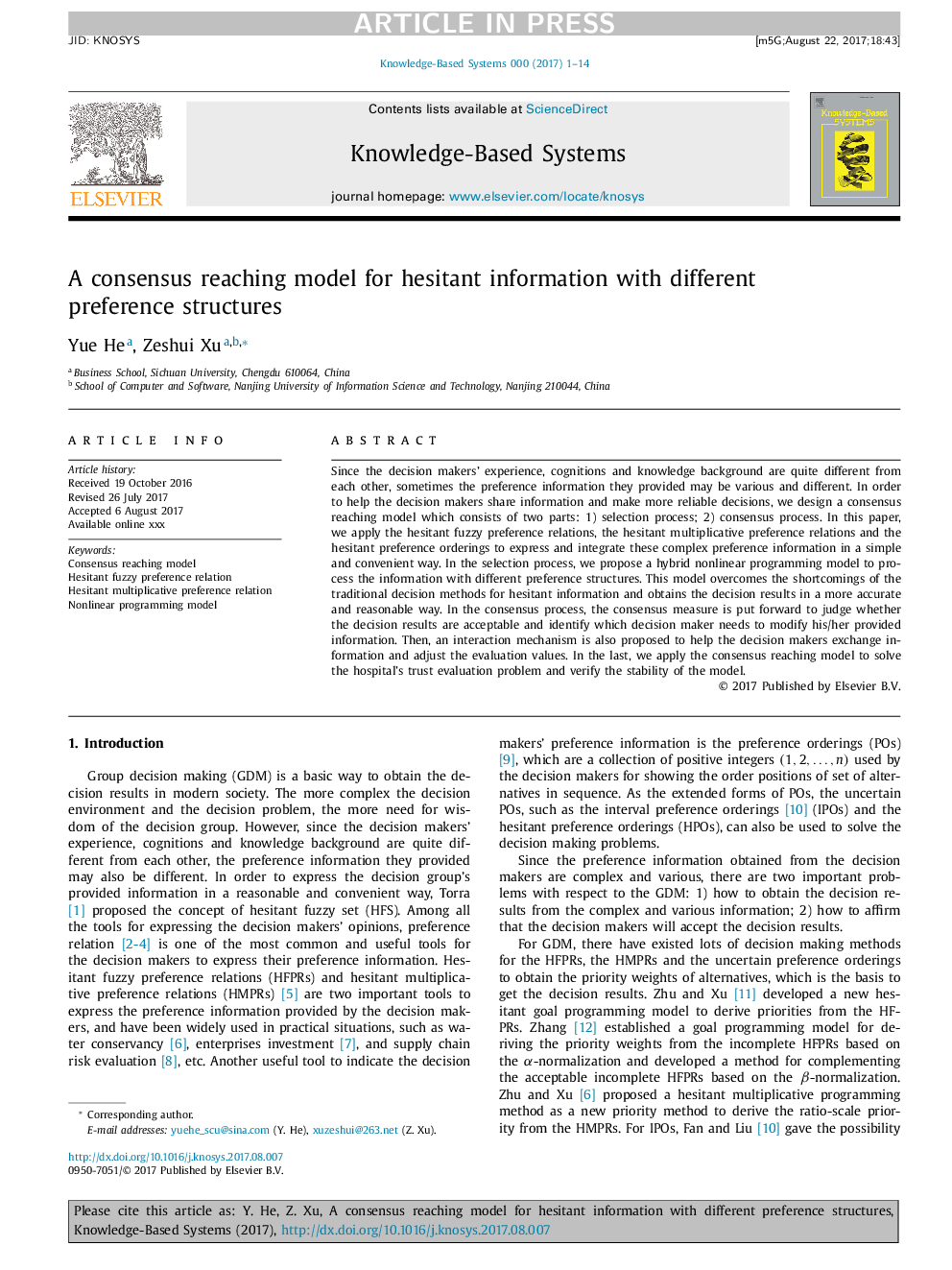| کد مقاله | کد نشریه | سال انتشار | مقاله انگلیسی | نسخه تمام متن |
|---|---|---|---|---|
| 4946054 | 1439266 | 2017 | 14 صفحه PDF | دانلود رایگان |
عنوان انگلیسی مقاله ISI
A consensus reaching model for hesitant information with different preference structures
ترجمه فارسی عنوان
مدل اجتناب ناپذیری برای اطلاعات تردید با ساختارهای ترجیحی مختلف
دانلود مقاله + سفارش ترجمه
دانلود مقاله ISI انگلیسی
رایگان برای ایرانیان
کلمات کلیدی
مدل هماهنگی، رابطه تداخل فازی ناخواسته، رابطه ترجیح چندانی تضعیف کننده، مدل برنامه نویسی غیر خطی،
ترجمه چکیده
از آنجا که تجربه، شناخت ها و زمینه های دانش تصمیم گیرندگان کاملا متفاوت از یکدیگرند، گاهی اوقات اطلاعات ترجیحی ارائه شده ممکن است متفاوت و متفاوت باشند. به منظور کمک به تصمیم گیرندگان اطلاعات را به اشتراک می گذاریم و تصمیمات قابل اعتمادتری را اتخاذ می کنیم، ما یک مدل رسیدن به اجماع را که شامل دو بخش است طراحی می کنیم: 1) پروسه انتخاب؛ 2) روند اجماع. در این مقاله، روابط ترجیحی فازی هنجارانه، روابط ترجیحی تکراری چندگانه و دستورالعمل های ترجیحی هنجار برای بیان و ادغام این اطلاعات ترجیحی پیچیده به شیوه ای ساده و راحت اعمال می شود. در فرایند انتخاب، ما یک مدل برنامه ریزی غیر خطی ترکیبی را برای پردازش اطلاعات با ساختارهای ترجیحی مختلف پیشنهاد می کنیم. این مدل نقاط ضعف روش های تصمیم گیری سنتی برای اطلاعات ناامید را برطرف می کند و نتایج تصمیم گیری را با روش دقیق تر و منطقی به دست می آورد. در فرایند اجماع، ارزیابی اجماع مطرح شده برای تعیین اینکه آیا نتایج تصمیم پذیرفته شده قابل قبول است یا خیر، مشخص شود که کدام تصمیم گیرنده نیاز دارد اطلاعات خود را تغییر دهد. سپس، یک مکانیسم تعامل نیز برای کمک به تصمیم گیرندگان مبادله اطلاعات و تنظیم ارزش های ارزیابی پیشنهاد شده است. در آخر ما برای دستیابی به مشکل اعتماد اعتماد بیمارستان و تأیید ثبات مدل، مدل توافق برای رسیدن به مدل را اعمال می کنیم.
موضوعات مرتبط
مهندسی و علوم پایه
مهندسی کامپیوتر
هوش مصنوعی
چکیده انگلیسی
Since the decision makers' experience, cognitions and knowledge background are quite different from each other, sometimes the preference information they provided may be various and different. In order to help the decision makers share information and make more reliable decisions, we design a consensus reaching model which consists of two parts: 1) selection process; 2) consensus process. In this paper, we apply the hesitant fuzzy preference relations, the hesitant multiplicative preference relations and the hesitant preference orderings to express and integrate these complex preference information in a simple and convenient way. In the selection process, we propose a hybrid nonlinear programming model to process the information with different preference structures. This model overcomes the shortcomings of the traditional decision methods for hesitant information and obtains the decision results in a more accurate and reasonable way. In the consensus process, the consensus measure is put forward to judge whether the decision results are acceptable and identify which decision maker needs to modify his/her provided information. Then, an interaction mechanism is also proposed to help the decision makers exchange information and adjust the evaluation values. In the last, we apply the consensus reaching model to solve the hospital's trust evaluation problem and verify the stability of the model.
ناشر
Database: Elsevier - ScienceDirect (ساینس دایرکت)
Journal: Knowledge-Based Systems - Volume 135, 1 November 2017, Pages 99-112
Journal: Knowledge-Based Systems - Volume 135, 1 November 2017, Pages 99-112
نویسندگان
He Yue, Xu Zeshui,
